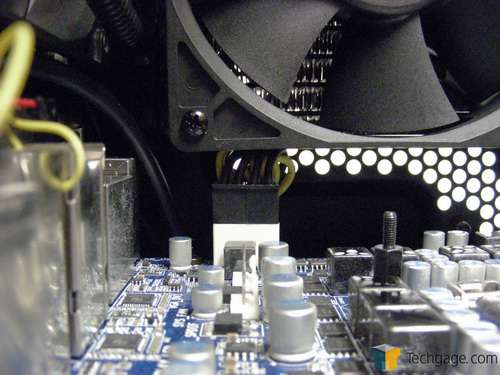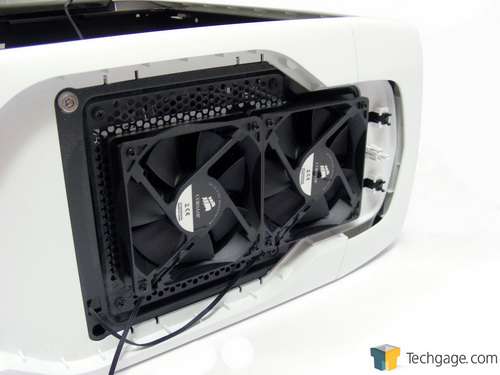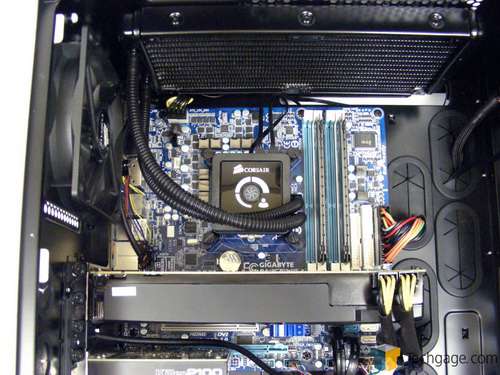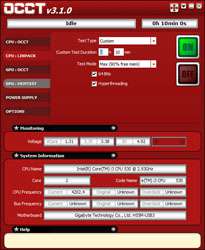- Qualcomm Launches Snapdragon 4 Gen 2 Mobile Platform
- AMD Launches Ryzen PRO 7000 Series Mobile & Desktop Platform
- Intel Launches Sleek Single-Slot Arc Pro A60 Workstation Graphics Card
- NVIDIA Announces Latest Ada Lovelace Additions: GeForce RTX 4060 Ti & RTX 4060
- Maxon Redshift With AMD Radeon GPU Rendering Support Now Available
Corsair H100 Self-Contained Liquid CPU Cooler Review
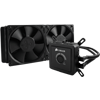
Corsair has yet to release a liquid CPU cooler we haven’t been impressed by, and the H100 doesn’t become an exception. Building on what made the H80 such an impressive performer, the H100 doubles the radiator length, enabling support for up to 4 fans. One thing it proves? Bigger can indeed be better.
Page 2 – Installation & Testing
Since the H100 uses the same mounting method as the H60 and H80 I’ll dispense with the installation instructions and refer those who are interested to the previous reviews for more information on that side of things.
Since 240mm radiator support is out of the question on our usual CPU cooler test system the duty has fallen on the shoulders of my personal rig. The case being used is a Corsair Special Edition White Graphite 600T that allows for the radiator to be installed in the top – but there was one snag.
During installation it was discovered that the 12V power connector and top clip on the DIMM slots that both run close to the edge of the motherboard would interfere with the fans installed on the bottom of the radiator to push air through the fins as the installation guide shows.
To work around this the fans were installed on the top but outside of the case to pull the air through instead. This pull configuration is the same that will be used during testing when the H100 goes up against a CoolIT Vantage C240 prototype, so even though the installation is not ideal, our testing will still show which of the two big boys is superior.
To show just where the performance of the H100 falls within the Hydro series, the H80 will also be tested using the standard two fan configuration. But before we get to that, have a look at the finished installation.
All of our testing is performed under controlled conditions to ensure accurate and repeatable results. The test system is kept in a near steady 20°C ambient environment with readings taken before and after testing with a standard room thermometer. AIDA64 Extreme Engineer is used for monitoring and recording temperatures throughout the test process.
Windows is allowed to sit idle for 10 minutes after startup to ensure all services are loaded before recording idle CPU temperatures. CPU load temperatures are generated by performing a 20 minute run of OCCT LINPACK using 90% of the available memory to generate as much heat as possible. All coolers will be set to the maximum performance mode allowable to ensure a level playing field.
Stock CPU settings were obtained by using the “Load Optimum Default” option in the motherboard BIOS and the maximum overclocked frequency of 4.2GHz was reached by setting the base clock to 191 and the multiplier to 22, while the Vcore was raised to 1.328V. Since this is my personal system that remains overclocked, I can personally vouch for stability.
The components used for testing are:
|
Component
|
Techgage Test System
|
| Processor |
Intel Core i3-530 – Dual-Core (2.93GHz)
|
| Motherboard |
GIGABYTE GA-H55M-USB3 – H55-based
|
| Memory |
G. Skill ECO 2x2GB DDR3-1600
|
| Graphics |
Sapphire Radeon HD 6850 Toxic Edition
|
| Audio |
On-Board Audio
|
| Storage |
Mushkin Callisto Deluxe 60GB
Western Digital Caviar Black 640GB |
| Power Supply |
SilverStone Strider Gold 750W
|
| Chassis |
Corsair SE White Graphite 600T
|
| CPU Cooling |
CoolIT Vantage A.L.C. C240
Corsair H80 Corsair H100 |
| Et cetera |
Bigfoot Killer NIC
Windows 7 Ultimate 64-bit |
And the results!
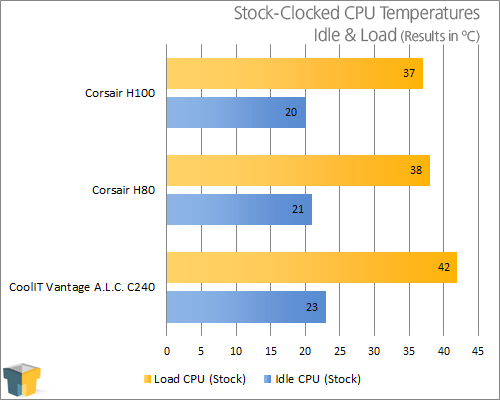
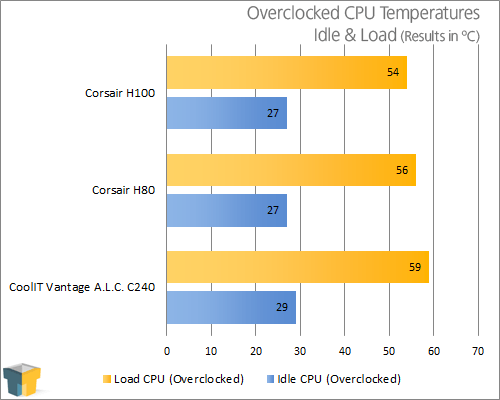
Initially I’m impressed with how the H80 was able to best the C240 by 3 degrees while overclocked and under full load. It goes to show just how efficient the new cold plate and double thick radiator are at pulling heat away from the CPU. But moving on to the reason for the review, the H100 is able to knock another 2 degrees off of the H80 proving that it is an extremely powerful cooling solution if case compatibility is there.
Sadly, I had intended to test the C240 and H100 with two fans on each side in a push/pull configuration but there simply is not enough clearance in the case. For those who are lucky enough to be running a case with lots of room such as a Cooler Master HAF 932, you should be able to shave even more off of the load temperatures.
To find out just how well the H100 cools while keeping sound to a minimum, another 20 minute load test was run with the system overclocked and the cooler set to the lowest performance level. In the end the cooler turned in a maximum temperature of 58 degrees, 1 degree better than the C240 in Extreme mode and still well within the thermal limit.
Sound is another matter. Users will need to decide what is more important – sound or cooling. The second performance setting gives a balance of the two but with maximum performance enabled the fans add a lot of additional noise to the system. With the lowest performance level selected the fans did not spin up during testing making for one quite system with only the rush of air to be heard.
Our testing has shown is that the H100 is very capable of handling some fairly mean overclocks, however an i7 will certainly generate more heat than a little i3 so performance can vary quite a bit although that should go without saying. What should be noted is that the fans did not reach their full speed during any of our testing so there is still plenty of cooling life left in the H100.
Support our efforts! With ad revenue at an all-time low for written websites, we're relying more than ever on reader support to help us continue putting so much effort into this type of content. You can support us by becoming a Patron, or by using our Amazon shopping affiliate links listed through our articles. Thanks for your support!




